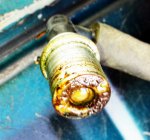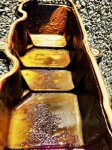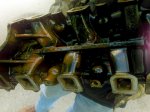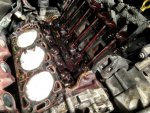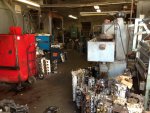raven
New Member
- Joined
- Mar 4, 2013
- Messages
- 19
- Reaction score
- 0
- Points
- 0
- Vehicle Year
- 2001
- Make / Model
- Ford
- Transmission
- Automatic
Hello, and this is my first forum post, but I've lurked here a long time.
I have a 2001 Ford Ranger XLT 3.0 V6 Flex Fuel automatic model purchased used, was a fleet vehicle that was decently abused before I received it with about 60k miles in late 2002. Since I have owned the truck, I have performed regular maintenance and some repairs. The truck currently has just under 200k on it now.
Problems started about a month ago, thermostat stuck closed, truck overheated rather quickly. In retrospect it would seem the truck overheated much quicker than the gauge indicated. Let the truck cool off, replaced the lost water, go to an auto parts store down the street without overheating, and replaced the thermostat. No problems at all noticed for three weeks.
About a week and a half ago started to get a very intermittent CEL, pulled code indicated Cylinder 3 misfire. The truck was running fine, no audible miss or shake, no loss of power, no smoke.
This Saturday, driving about 80 mph on the highway, experienced a sudden loss of power, transmission downshifted, then the most 'smoke' from under the hood I've ever seen a vehicle create while not on fire. Had to move across 4 crowded lanes of traffic to pull off, which took about a minute and a half due to zero visibility to do safely and not causing or getting into an accident was my first priority. The heat gauge was slow to respond at first but then quickly went almost to the H by the time I was able to stop and shut her off, amazingly right in front of a friends car dealership.
Initial inspection showed the radiator had burst along the seams of the right-side plastic end-caps, spraying all the engine coolant directly into the intake and soaking the air filter and air box.
Purchased a radiator and changed it in the parking lot, refilled coolant, and started it up. Hard start, running with flashing CEL, terrible miss, sounds like a dead cylinder. After about a minute, the exhaust was leaking antifreeze and a few seconds later started billowing thick white smoke that smelled sweet burnt wood. The overflow was boiling aggressively and smelled of exhaust. Shut it down and later on it would not restart (like it was hydro-locked). Dipstick is black with no visible signs of coolant and oil mixing.
Pulled valve covers and intake, the passenger side bank look horrendous with coolant all over the area of cylinder 3. Pulled the head off, have not yet cleaned everything but no visible cracking. The head gasket was examined by myself and two friends and looks perfect. The internal condition of the motor is fair, reddish varnish, but all rods are straight and no other visible damage. Some sludge and carbon but nothing tragic for the miles.
I normally would have done through checks before disassembly, but having had similar happen on other cars I was betting everything on the head gasket having blown - I worked on the thing for about many hours to get to it, so if it was obviously bad I would have reassembled it there in the parking lot and been back on the road by the next morning after the epic effort, unfortunately not so luckly. =(
I will be removing the other head ASAP and taking them to a cylinder head specialty machine shop to get magnaflux tested, they say they can test both for $50. I am hoping at this point the head is bad and the block is not cracked.
While I am at it, is there anything else I should know to ensure a quality repair? Please keep in mind I am working on this car in a parking lot which is 20 miles from my home with limited access to my tools. I have purchased a full FP gasket set, water pump, PCV, thermostat, wires/plugs, air filter, fluids, etc. At this point I'm hoping the heads are bad, as I've found a decent sent for about $400 but will need to be shipped. Also, is there any way to know if the block is cracked at this point? I know it isn't common, but I don't want to throw another $400-$500 at it (that I don't have!), when a new motor from EngineGuy is $1400!
Thank you for suggestions. I have some pictures I can attach later.
I have a 2001 Ford Ranger XLT 3.0 V6 Flex Fuel automatic model purchased used, was a fleet vehicle that was decently abused before I received it with about 60k miles in late 2002. Since I have owned the truck, I have performed regular maintenance and some repairs. The truck currently has just under 200k on it now.
Problems started about a month ago, thermostat stuck closed, truck overheated rather quickly. In retrospect it would seem the truck overheated much quicker than the gauge indicated. Let the truck cool off, replaced the lost water, go to an auto parts store down the street without overheating, and replaced the thermostat. No problems at all noticed for three weeks.
About a week and a half ago started to get a very intermittent CEL, pulled code indicated Cylinder 3 misfire. The truck was running fine, no audible miss or shake, no loss of power, no smoke.
This Saturday, driving about 80 mph on the highway, experienced a sudden loss of power, transmission downshifted, then the most 'smoke' from under the hood I've ever seen a vehicle create while not on fire. Had to move across 4 crowded lanes of traffic to pull off, which took about a minute and a half due to zero visibility to do safely and not causing or getting into an accident was my first priority. The heat gauge was slow to respond at first but then quickly went almost to the H by the time I was able to stop and shut her off, amazingly right in front of a friends car dealership.
Initial inspection showed the radiator had burst along the seams of the right-side plastic end-caps, spraying all the engine coolant directly into the intake and soaking the air filter and air box.
Purchased a radiator and changed it in the parking lot, refilled coolant, and started it up. Hard start, running with flashing CEL, terrible miss, sounds like a dead cylinder. After about a minute, the exhaust was leaking antifreeze and a few seconds later started billowing thick white smoke that smelled sweet burnt wood. The overflow was boiling aggressively and smelled of exhaust. Shut it down and later on it would not restart (like it was hydro-locked). Dipstick is black with no visible signs of coolant and oil mixing.
Pulled valve covers and intake, the passenger side bank look horrendous with coolant all over the area of cylinder 3. Pulled the head off, have not yet cleaned everything but no visible cracking. The head gasket was examined by myself and two friends and looks perfect. The internal condition of the motor is fair, reddish varnish, but all rods are straight and no other visible damage. Some sludge and carbon but nothing tragic for the miles.
I normally would have done through checks before disassembly, but having had similar happen on other cars I was betting everything on the head gasket having blown - I worked on the thing for about many hours to get to it, so if it was obviously bad I would have reassembled it there in the parking lot and been back on the road by the next morning after the epic effort, unfortunately not so luckly. =(
I will be removing the other head ASAP and taking them to a cylinder head specialty machine shop to get magnaflux tested, they say they can test both for $50. I am hoping at this point the head is bad and the block is not cracked.
While I am at it, is there anything else I should know to ensure a quality repair? Please keep in mind I am working on this car in a parking lot which is 20 miles from my home with limited access to my tools. I have purchased a full FP gasket set, water pump, PCV, thermostat, wires/plugs, air filter, fluids, etc. At this point I'm hoping the heads are bad, as I've found a decent sent for about $400 but will need to be shipped. Also, is there any way to know if the block is cracked at this point? I know it isn't common, but I don't want to throw another $400-$500 at it (that I don't have!), when a new motor from EngineGuy is $1400!
Thank you for suggestions. I have some pictures I can attach later.
Last edited:

